Analysis of Qantas Pricing Strategies, CRM, and Servicescape
VerifiedAdded on 2021/06/15
|5
|2141
|66
Report
AI Summary
This report provides a detailed analysis of Qantas's service pricing strategies, customer relationship management (CRM), and servicescape. It examines the airline's historical pricing methods, including cost-plus, market-determined, and competition-based approaches, and analyzes its current strategies such as price penetration with Jetstar, non-discounted fares, and promotional fares. The report also assesses the importance of customer loyalty to Qantas, exploring factors influencing loyalty and the effectiveness of its strategies. Furthermore, it evaluates Qantas's servicescape, including departure lounges and the aircraft environment, and discusses how these elements impact customer experience. The report concludes with recommendations for Qantas to enhance its marketing strategies, customer loyalty programs, and overall service offerings, including suggestions for holistic marketing, expanded frequent flyer programs, co-creation, and personalized services.
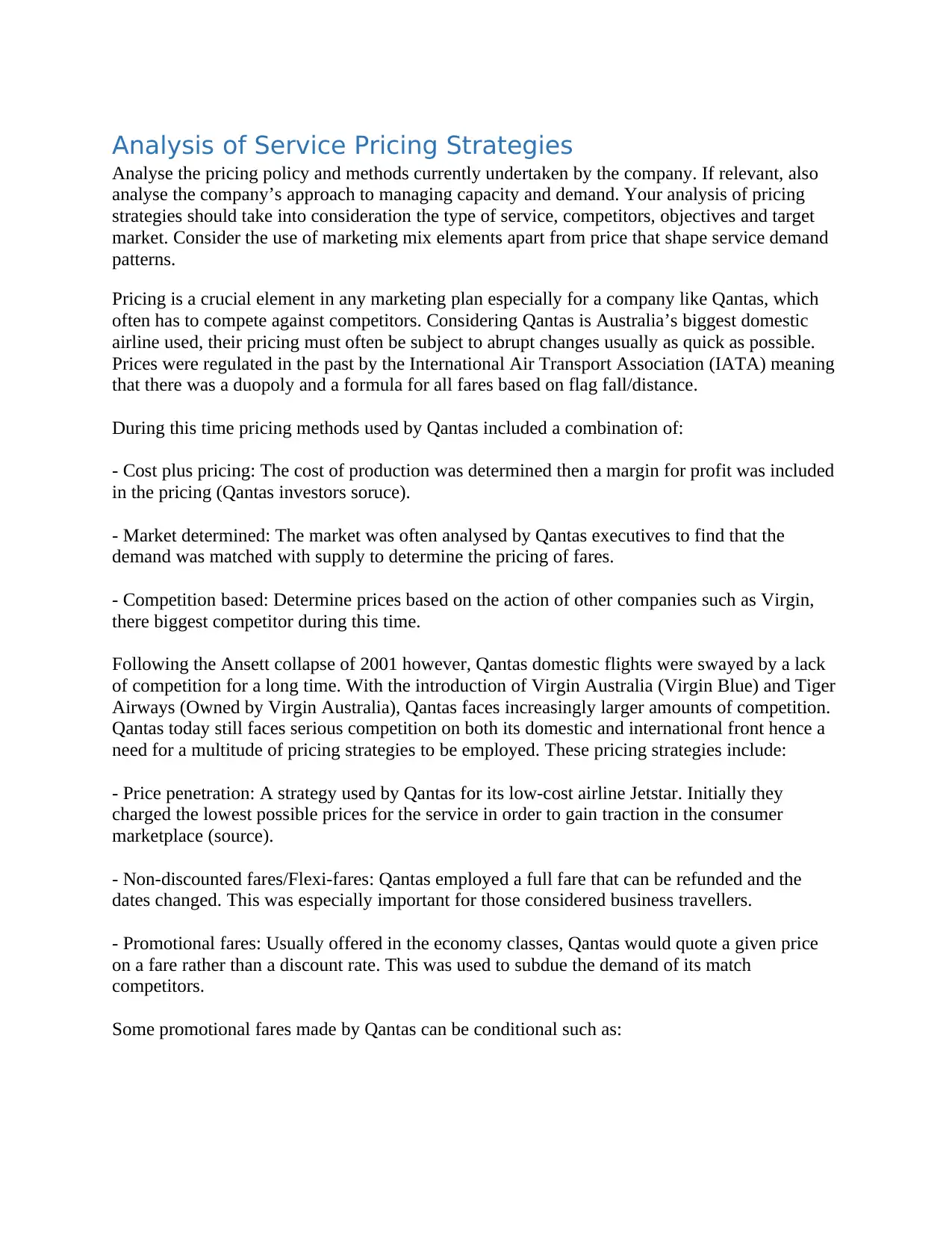
Analysis of Service Pricing Strategies
Analyse the pricing policy and methods currently undertaken by the company. If relevant, also
analyse the company’s approach to managing capacity and demand. Your analysis of pricing
strategies should take into consideration the type of service, competitors, objectives and target
market. Consider the use of marketing mix elements apart from price that shape service demand
patterns.
Pricing is a crucial element in any marketing plan especially for a company like Qantas, which
often has to compete against competitors. Considering Qantas is Australia’s biggest domestic
airline used, their pricing must often be subject to abrupt changes usually as quick as possible.
Prices were regulated in the past by the International Air Transport Association (IATA) meaning
that there was a duopoly and a formula for all fares based on flag fall/distance.
During this time pricing methods used by Qantas included a combination of:
- Cost plus pricing: The cost of production was determined then a margin for profit was included
in the pricing (Qantas investors soruce).
- Market determined: The market was often analysed by Qantas executives to find that the
demand was matched with supply to determine the pricing of fares.
- Competition based: Determine prices based on the action of other companies such as Virgin,
there biggest competitor during this time.
Following the Ansett collapse of 2001 however, Qantas domestic flights were swayed by a lack
of competition for a long time. With the introduction of Virgin Australia (Virgin Blue) and Tiger
Airways (Owned by Virgin Australia), Qantas faces increasingly larger amounts of competition.
Qantas today still faces serious competition on both its domestic and international front hence a
need for a multitude of pricing strategies to be employed. These pricing strategies include:
- Price penetration: A strategy used by Qantas for its low-cost airline Jetstar. Initially they
charged the lowest possible prices for the service in order to gain traction in the consumer
marketplace (source).
- Non-discounted fares/Flexi-fares: Qantas employed a full fare that can be refunded and the
dates changed. This was especially important for those considered business travellers.
- Promotional fares: Usually offered in the economy classes, Qantas would quote a given price
on a fare rather than a discount rate. This was used to subdue the demand of its match
competitors.
Some promotional fares made by Qantas can be conditional such as:
Analyse the pricing policy and methods currently undertaken by the company. If relevant, also
analyse the company’s approach to managing capacity and demand. Your analysis of pricing
strategies should take into consideration the type of service, competitors, objectives and target
market. Consider the use of marketing mix elements apart from price that shape service demand
patterns.
Pricing is a crucial element in any marketing plan especially for a company like Qantas, which
often has to compete against competitors. Considering Qantas is Australia’s biggest domestic
airline used, their pricing must often be subject to abrupt changes usually as quick as possible.
Prices were regulated in the past by the International Air Transport Association (IATA) meaning
that there was a duopoly and a formula for all fares based on flag fall/distance.
During this time pricing methods used by Qantas included a combination of:
- Cost plus pricing: The cost of production was determined then a margin for profit was included
in the pricing (Qantas investors soruce).
- Market determined: The market was often analysed by Qantas executives to find that the
demand was matched with supply to determine the pricing of fares.
- Competition based: Determine prices based on the action of other companies such as Virgin,
there biggest competitor during this time.
Following the Ansett collapse of 2001 however, Qantas domestic flights were swayed by a lack
of competition for a long time. With the introduction of Virgin Australia (Virgin Blue) and Tiger
Airways (Owned by Virgin Australia), Qantas faces increasingly larger amounts of competition.
Qantas today still faces serious competition on both its domestic and international front hence a
need for a multitude of pricing strategies to be employed. These pricing strategies include:
- Price penetration: A strategy used by Qantas for its low-cost airline Jetstar. Initially they
charged the lowest possible prices for the service in order to gain traction in the consumer
marketplace (source).
- Non-discounted fares/Flexi-fares: Qantas employed a full fare that can be refunded and the
dates changed. This was especially important for those considered business travellers.
- Promotional fares: Usually offered in the economy classes, Qantas would quote a given price
on a fare rather than a discount rate. This was used to subdue the demand of its match
competitors.
Some promotional fares made by Qantas can be conditional such as:
Paraphrase This Document
Need a fresh take? Get an instant paraphrase of this document with our AI Paraphraser
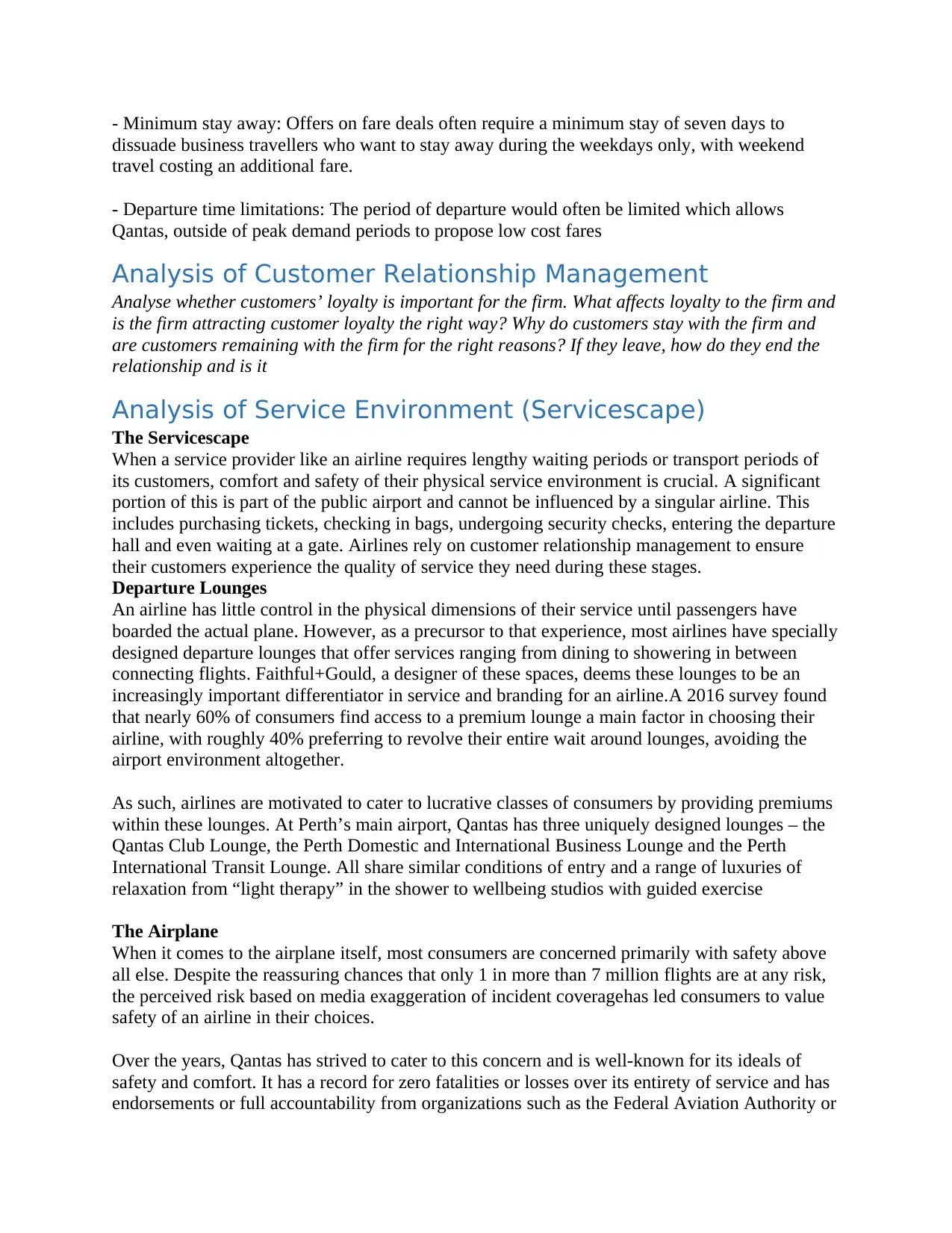
- Minimum stay away: Offers on fare deals often require a minimum stay of seven days to
dissuade business travellers who want to stay away during the weekdays only, with weekend
travel costing an additional fare.
- Departure time limitations: The period of departure would often be limited which allows
Qantas, outside of peak demand periods to propose low cost fares
Analysis of Customer Relationship Management
Analyse whether customers’ loyalty is important for the firm. What affects loyalty to the firm and
is the firm attracting customer loyalty the right way? Why do customers stay with the firm and
are customers remaining with the firm for the right reasons? If they leave, how do they end the
relationship and is it
Analysis of Service Environment (Servicescape)
The Servicescape
When a service provider like an airline requires lengthy waiting periods or transport periods of
its customers, comfort and safety of their physical service environment is crucial. A significant
portion of this is part of the public airport and cannot be influenced by a singular airline. This
includes purchasing tickets, checking in bags, undergoing security checks, entering the departure
hall and even waiting at a gate. Airlines rely on customer relationship management to ensure
their customers experience the quality of service they need during these stages.
Departure Lounges
An airline has little control in the physical dimensions of their service until passengers have
boarded the actual plane. However, as a precursor to that experience, most airlines have specially
designed departure lounges that offer services ranging from dining to showering in between
connecting flights. Faithful+Gould, a designer of these spaces, deems these lounges to be an
increasingly important differentiator in service and branding for an airline.A 2016 survey found
that nearly 60% of consumers find access to a premium lounge a main factor in choosing their
airline, with roughly 40% preferring to revolve their entire wait around lounges, avoiding the
airport environment altogether.
As such, airlines are motivated to cater to lucrative classes of consumers by providing premiums
within these lounges. At Perth’s main airport, Qantas has three uniquely designed lounges – the
Qantas Club Lounge, the Perth Domestic and International Business Lounge and the Perth
International Transit Lounge. All share similar conditions of entry and a range of luxuries of
relaxation from “light therapy” in the shower to wellbeing studios with guided exercise
The Airplane
When it comes to the airplane itself, most consumers are concerned primarily with safety above
all else. Despite the reassuring chances that only 1 in more than 7 million flights are at any risk,
the perceived risk based on media exaggeration of incident coveragehas led consumers to value
safety of an airline in their choices.
Over the years, Qantas has strived to cater to this concern and is well-known for its ideals of
safety and comfort. It has a record for zero fatalities or losses over its entirety of service and has
endorsements or full accountability from organizations such as the Federal Aviation Authority or
dissuade business travellers who want to stay away during the weekdays only, with weekend
travel costing an additional fare.
- Departure time limitations: The period of departure would often be limited which allows
Qantas, outside of peak demand periods to propose low cost fares
Analysis of Customer Relationship Management
Analyse whether customers’ loyalty is important for the firm. What affects loyalty to the firm and
is the firm attracting customer loyalty the right way? Why do customers stay with the firm and
are customers remaining with the firm for the right reasons? If they leave, how do they end the
relationship and is it
Analysis of Service Environment (Servicescape)
The Servicescape
When a service provider like an airline requires lengthy waiting periods or transport periods of
its customers, comfort and safety of their physical service environment is crucial. A significant
portion of this is part of the public airport and cannot be influenced by a singular airline. This
includes purchasing tickets, checking in bags, undergoing security checks, entering the departure
hall and even waiting at a gate. Airlines rely on customer relationship management to ensure
their customers experience the quality of service they need during these stages.
Departure Lounges
An airline has little control in the physical dimensions of their service until passengers have
boarded the actual plane. However, as a precursor to that experience, most airlines have specially
designed departure lounges that offer services ranging from dining to showering in between
connecting flights. Faithful+Gould, a designer of these spaces, deems these lounges to be an
increasingly important differentiator in service and branding for an airline.A 2016 survey found
that nearly 60% of consumers find access to a premium lounge a main factor in choosing their
airline, with roughly 40% preferring to revolve their entire wait around lounges, avoiding the
airport environment altogether.
As such, airlines are motivated to cater to lucrative classes of consumers by providing premiums
within these lounges. At Perth’s main airport, Qantas has three uniquely designed lounges – the
Qantas Club Lounge, the Perth Domestic and International Business Lounge and the Perth
International Transit Lounge. All share similar conditions of entry and a range of luxuries of
relaxation from “light therapy” in the shower to wellbeing studios with guided exercise
The Airplane
When it comes to the airplane itself, most consumers are concerned primarily with safety above
all else. Despite the reassuring chances that only 1 in more than 7 million flights are at any risk,
the perceived risk based on media exaggeration of incident coveragehas led consumers to value
safety of an airline in their choices.
Over the years, Qantas has strived to cater to this concern and is well-known for its ideals of
safety and comfort. It has a record for zero fatalities or losses over its entirety of service and has
endorsements or full accountability from organizations such as the Federal Aviation Authority or
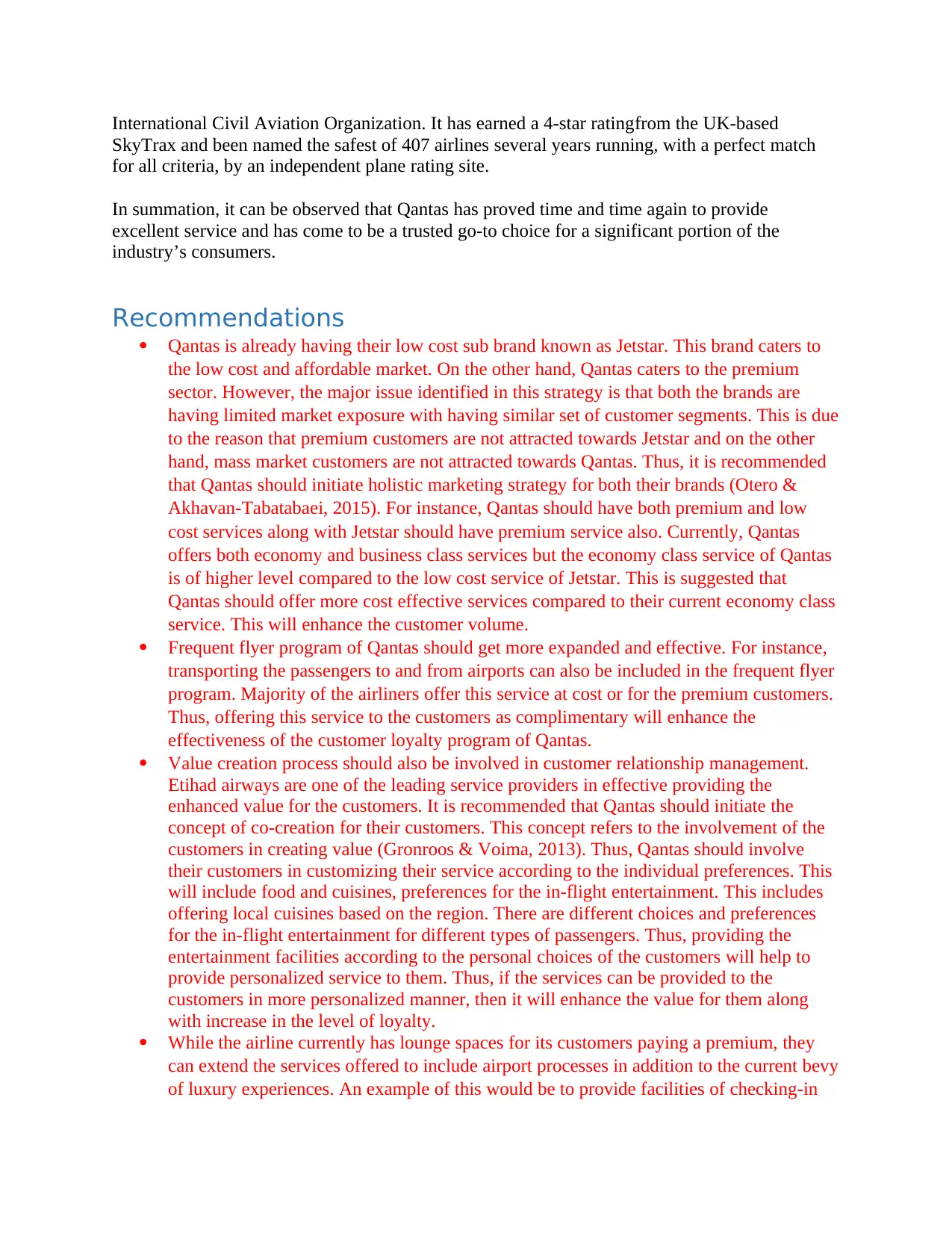
International Civil Aviation Organization. It has earned a 4-star ratingfrom the UK-based
SkyTrax and been named the safest of 407 airlines several years running, with a perfect match
for all criteria, by an independent plane rating site.
In summation, it can be observed that Qantas has proved time and time again to provide
excellent service and has come to be a trusted go-to choice for a significant portion of the
industry’s consumers.
Recommendations
Qantas is already having their low cost sub brand known as Jetstar. This brand caters to
the low cost and affordable market. On the other hand, Qantas caters to the premium
sector. However, the major issue identified in this strategy is that both the brands are
having limited market exposure with having similar set of customer segments. This is due
to the reason that premium customers are not attracted towards Jetstar and on the other
hand, mass market customers are not attracted towards Qantas. Thus, it is recommended
that Qantas should initiate holistic marketing strategy for both their brands (Otero &
Akhavan-Tabatabaei, 2015). For instance, Qantas should have both premium and low
cost services along with Jetstar should have premium service also. Currently, Qantas
offers both economy and business class services but the economy class service of Qantas
is of higher level compared to the low cost service of Jetstar. This is suggested that
Qantas should offer more cost effective services compared to their current economy class
service. This will enhance the customer volume.
Frequent flyer program of Qantas should get more expanded and effective. For instance,
transporting the passengers to and from airports can also be included in the frequent flyer
program. Majority of the airliners offer this service at cost or for the premium customers.
Thus, offering this service to the customers as complimentary will enhance the
effectiveness of the customer loyalty program of Qantas.
Value creation process should also be involved in customer relationship management.
Etihad airways are one of the leading service providers in effective providing the
enhanced value for the customers. It is recommended that Qantas should initiate the
concept of co-creation for their customers. This concept refers to the involvement of the
customers in creating value (Gronroos & Voima, 2013). Thus, Qantas should involve
their customers in customizing their service according to the individual preferences. This
will include food and cuisines, preferences for the in-flight entertainment. This includes
offering local cuisines based on the region. There are different choices and preferences
for the in-flight entertainment for different types of passengers. Thus, providing the
entertainment facilities according to the personal choices of the customers will help to
provide personalized service to them. Thus, if the services can be provided to the
customers in more personalized manner, then it will enhance the value for them along
with increase in the level of loyalty.
While the airline currently has lounge spaces for its customers paying a premium, they
can extend the services offered to include airport processes in addition to the current bevy
of luxury experiences. An example of this would be to provide facilities of checking-in
SkyTrax and been named the safest of 407 airlines several years running, with a perfect match
for all criteria, by an independent plane rating site.
In summation, it can be observed that Qantas has proved time and time again to provide
excellent service and has come to be a trusted go-to choice for a significant portion of the
industry’s consumers.
Recommendations
Qantas is already having their low cost sub brand known as Jetstar. This brand caters to
the low cost and affordable market. On the other hand, Qantas caters to the premium
sector. However, the major issue identified in this strategy is that both the brands are
having limited market exposure with having similar set of customer segments. This is due
to the reason that premium customers are not attracted towards Jetstar and on the other
hand, mass market customers are not attracted towards Qantas. Thus, it is recommended
that Qantas should initiate holistic marketing strategy for both their brands (Otero &
Akhavan-Tabatabaei, 2015). For instance, Qantas should have both premium and low
cost services along with Jetstar should have premium service also. Currently, Qantas
offers both economy and business class services but the economy class service of Qantas
is of higher level compared to the low cost service of Jetstar. This is suggested that
Qantas should offer more cost effective services compared to their current economy class
service. This will enhance the customer volume.
Frequent flyer program of Qantas should get more expanded and effective. For instance,
transporting the passengers to and from airports can also be included in the frequent flyer
program. Majority of the airliners offer this service at cost or for the premium customers.
Thus, offering this service to the customers as complimentary will enhance the
effectiveness of the customer loyalty program of Qantas.
Value creation process should also be involved in customer relationship management.
Etihad airways are one of the leading service providers in effective providing the
enhanced value for the customers. It is recommended that Qantas should initiate the
concept of co-creation for their customers. This concept refers to the involvement of the
customers in creating value (Gronroos & Voima, 2013). Thus, Qantas should involve
their customers in customizing their service according to the individual preferences. This
will include food and cuisines, preferences for the in-flight entertainment. This includes
offering local cuisines based on the region. There are different choices and preferences
for the in-flight entertainment for different types of passengers. Thus, providing the
entertainment facilities according to the personal choices of the customers will help to
provide personalized service to them. Thus, if the services can be provided to the
customers in more personalized manner, then it will enhance the value for them along
with increase in the level of loyalty.
While the airline currently has lounge spaces for its customers paying a premium, they
can extend the services offered to include airport processes in addition to the current bevy
of luxury experiences. An example of this would be to provide facilities of checking-in
⊘ This is a preview!⊘
Do you want full access?
Subscribe today to unlock all pages.

Trusted by 1+ million students worldwide
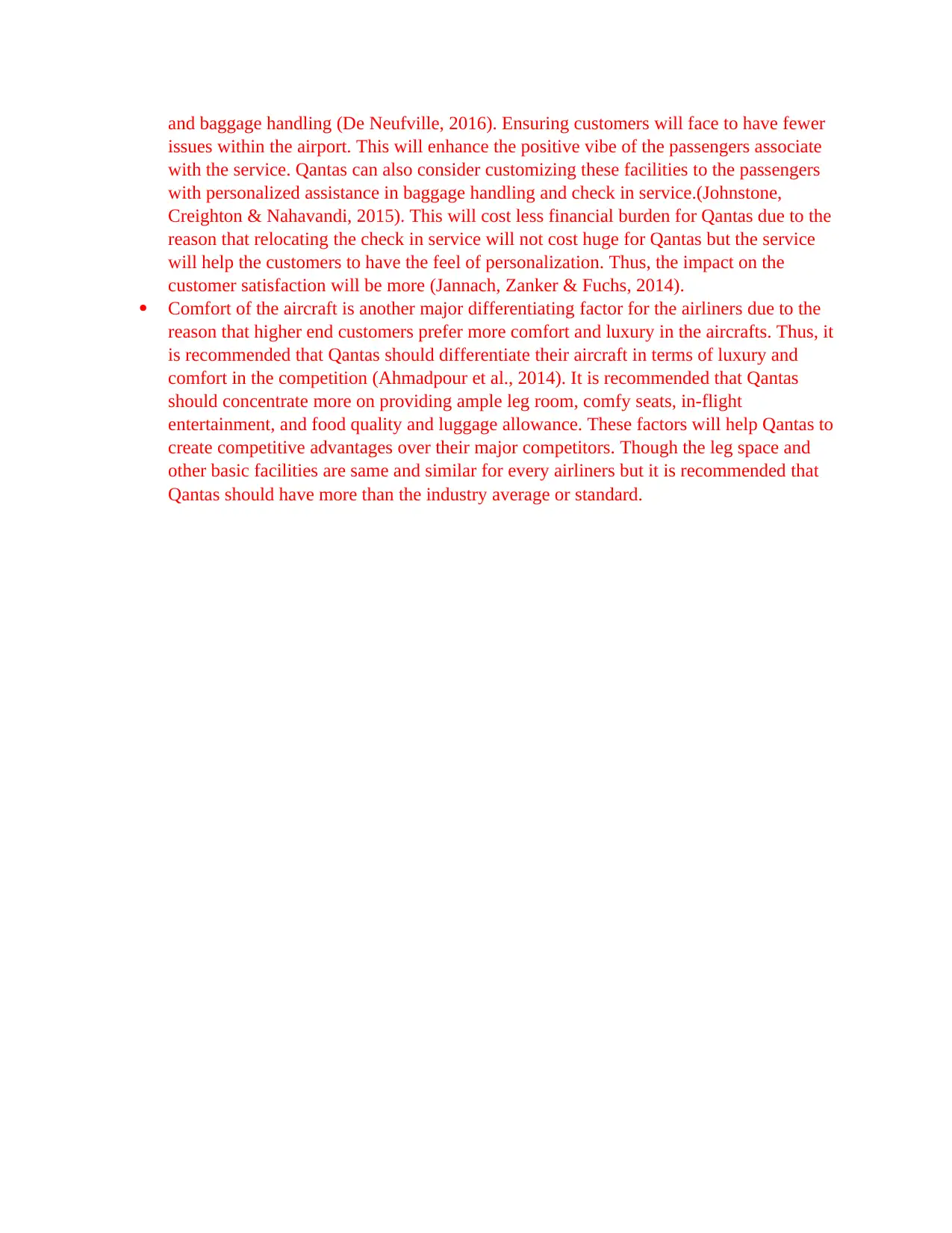
and baggage handling (De Neufville, 2016). Ensuring customers will face to have fewer
issues within the airport. This will enhance the positive vibe of the passengers associate
with the service. Qantas can also consider customizing these facilities to the passengers
with personalized assistance in baggage handling and check in service.(Johnstone,
Creighton & Nahavandi, 2015). This will cost less financial burden for Qantas due to the
reason that relocating the check in service will not cost huge for Qantas but the service
will help the customers to have the feel of personalization. Thus, the impact on the
customer satisfaction will be more (Jannach, Zanker & Fuchs, 2014).
Comfort of the aircraft is another major differentiating factor for the airliners due to the
reason that higher end customers prefer more comfort and luxury in the aircrafts. Thus, it
is recommended that Qantas should differentiate their aircraft in terms of luxury and
comfort in the competition (Ahmadpour et al., 2014). It is recommended that Qantas
should concentrate more on providing ample leg room, comfy seats, in-flight
entertainment, and food quality and luggage allowance. These factors will help Qantas to
create competitive advantages over their major competitors. Though the leg space and
other basic facilities are same and similar for every airliners but it is recommended that
Qantas should have more than the industry average or standard.
issues within the airport. This will enhance the positive vibe of the passengers associate
with the service. Qantas can also consider customizing these facilities to the passengers
with personalized assistance in baggage handling and check in service.(Johnstone,
Creighton & Nahavandi, 2015). This will cost less financial burden for Qantas due to the
reason that relocating the check in service will not cost huge for Qantas but the service
will help the customers to have the feel of personalization. Thus, the impact on the
customer satisfaction will be more (Jannach, Zanker & Fuchs, 2014).
Comfort of the aircraft is another major differentiating factor for the airliners due to the
reason that higher end customers prefer more comfort and luxury in the aircrafts. Thus, it
is recommended that Qantas should differentiate their aircraft in terms of luxury and
comfort in the competition (Ahmadpour et al., 2014). It is recommended that Qantas
should concentrate more on providing ample leg room, comfy seats, in-flight
entertainment, and food quality and luggage allowance. These factors will help Qantas to
create competitive advantages over their major competitors. Though the leg space and
other basic facilities are same and similar for every airliners but it is recommended that
Qantas should have more than the industry average or standard.
Paraphrase This Document
Need a fresh take? Get an instant paraphrase of this document with our AI Paraphraser
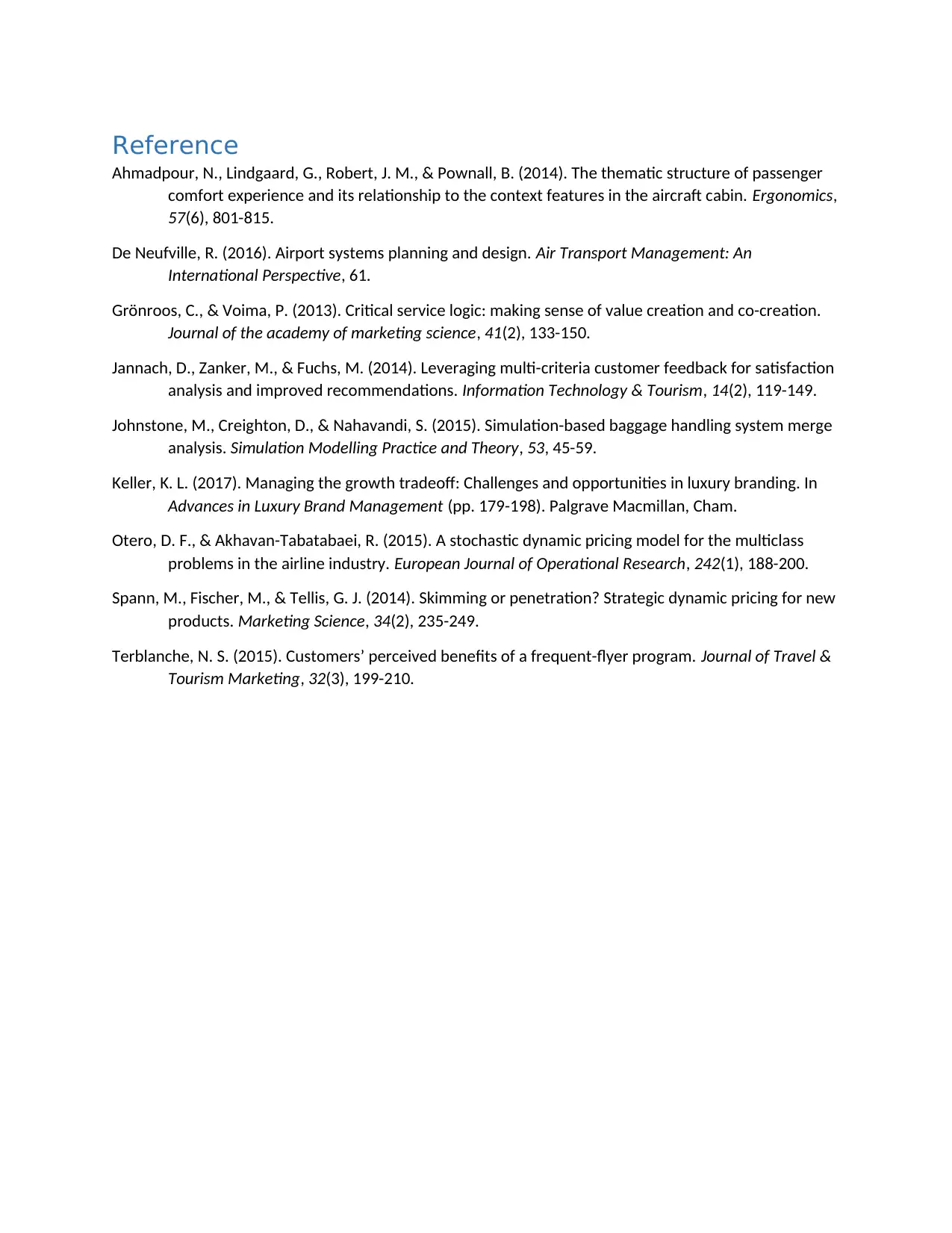
Reference
Ahmadpour, N., Lindgaard, G., Robert, J. M., & Pownall, B. (2014). The thematic structure of passenger
comfort experience and its relationship to the context features in the aircraft cabin. Ergonomics,
57(6), 801-815.
De Neufville, R. (2016). Airport systems planning and design. Air Transport Management: An
International Perspective, 61.
Grönroos, C., & Voima, P. (2013). Critical service logic: making sense of value creation and co-creation.
Journal of the academy of marketing science, 41(2), 133-150.
Jannach, D., Zanker, M., & Fuchs, M. (2014). Leveraging multi-criteria customer feedback for satisfaction
analysis and improved recommendations. Information Technology & Tourism, 14(2), 119-149.
Johnstone, M., Creighton, D., & Nahavandi, S. (2015). Simulation-based baggage handling system merge
analysis. Simulation Modelling Practice and Theory, 53, 45-59.
Keller, K. L. (2017). Managing the growth tradeoff: Challenges and opportunities in luxury branding. In
Advances in Luxury Brand Management (pp. 179-198). Palgrave Macmillan, Cham.
Otero, D. F., & Akhavan-Tabatabaei, R. (2015). A stochastic dynamic pricing model for the multiclass
problems in the airline industry. European Journal of Operational Research, 242(1), 188-200.
Spann, M., Fischer, M., & Tellis, G. J. (2014). Skimming or penetration? Strategic dynamic pricing for new
products. Marketing Science, 34(2), 235-249.
Terblanche, N. S. (2015). Customers’ perceived benefits of a frequent-flyer program. Journal of Travel &
Tourism Marketing, 32(3), 199-210.
Ahmadpour, N., Lindgaard, G., Robert, J. M., & Pownall, B. (2014). The thematic structure of passenger
comfort experience and its relationship to the context features in the aircraft cabin. Ergonomics,
57(6), 801-815.
De Neufville, R. (2016). Airport systems planning and design. Air Transport Management: An
International Perspective, 61.
Grönroos, C., & Voima, P. (2013). Critical service logic: making sense of value creation and co-creation.
Journal of the academy of marketing science, 41(2), 133-150.
Jannach, D., Zanker, M., & Fuchs, M. (2014). Leveraging multi-criteria customer feedback for satisfaction
analysis and improved recommendations. Information Technology & Tourism, 14(2), 119-149.
Johnstone, M., Creighton, D., & Nahavandi, S. (2015). Simulation-based baggage handling system merge
analysis. Simulation Modelling Practice and Theory, 53, 45-59.
Keller, K. L. (2017). Managing the growth tradeoff: Challenges and opportunities in luxury branding. In
Advances in Luxury Brand Management (pp. 179-198). Palgrave Macmillan, Cham.
Otero, D. F., & Akhavan-Tabatabaei, R. (2015). A stochastic dynamic pricing model for the multiclass
problems in the airline industry. European Journal of Operational Research, 242(1), 188-200.
Spann, M., Fischer, M., & Tellis, G. J. (2014). Skimming or penetration? Strategic dynamic pricing for new
products. Marketing Science, 34(2), 235-249.
Terblanche, N. S. (2015). Customers’ perceived benefits of a frequent-flyer program. Journal of Travel &
Tourism Marketing, 32(3), 199-210.
1 out of 5
Related Documents
Your All-in-One AI-Powered Toolkit for Academic Success.
+13062052269
info@desklib.com
Available 24*7 on WhatsApp / Email
![[object Object]](/_next/static/media/star-bottom.7253800d.svg)
Unlock your academic potential
Copyright © 2020–2025 A2Z Services. All Rights Reserved. Developed and managed by ZUCOL.





